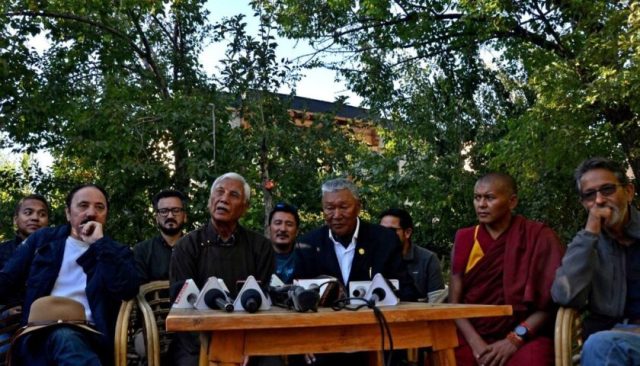A gradual rise in temperature and receding glaciers during summer have turned out to be a challenge for people of the cold desert in Ladakh. Experts and local residents believe that some “drastic and immediate remedial measures” are required to deal with the changing climate in the region.
What is more worrying is that “glacier lake bursts” (melting of glaciers and formation of lakes), which is triggering floods in Ladakh, has become a regular phenomenon. Man-induced anthropogenic interference and global warming are attributed as the main reasons for it.
 “In recent years, we have experienced this kind of climate change (high rain in summer and less snowfall in winter), which can be a part of global warming. Its intensity has increased and it is happening almost every year now. It is a matter of concern for people of Ladakh,” said Jigmet Takpa, Chief Conservator of Forests, Ladakh. He recently took part in the United Nations Conference on Climate Change at Paris in France.
“In recent years, we have experienced this kind of climate change (high rain in summer and less snowfall in winter), which can be a part of global warming. Its intensity has increased and it is happening almost every year now. It is a matter of concern for people of Ladakh,” said Jigmet Takpa, Chief Conservator of Forests, Ladakh. He recently took part in the United Nations Conference on Climate Change at Paris in France.
Takpa said the temperature was gradually soaring in Ladakh, which had enhanced the frequency of creation of artificial lakes due to melting of glaciers, causing danger to life and property in the region.
“Earlier, there used to be floods once in a decade in Ladakh. Now, it has become a permanent phenomenon. Incidents of heavy rain in July and August have gone up and there has been uncertainty and unpredictability among people about climate change. It is happening because of human-induced anthropogenic interference,” he said.
Takpa, however, said water had become a big challenge for people as they feared a drought-like situation in the near future because glaciers had been melting and shrinking in the region. “People along streams fear that they may face a water crisis in the near future due to melting and shrinking of glaciers,” he said.
Sonam Lotus, Regional Director, Meteorological Department, who belongs to Ladakh, said there had been an “agricultural shift” due to change in climate pattern in the region.
“There has been a gradual rise in temperature, but this rise is not significant for the time being. In the global pattern, there is melting of glaciers, but it will be wrong to say that temperature in winter is relatively high these days. The lowest-ever temperature in Ladakh was minus 28°C, which was recorded many decades ago. These were extreme weather conditions which happen once in many years,” he said.
Leh district had suffered colossal damage to government and private infrastructure and its impact this time was quite higher than what the district had witnessed in 2010 flash floods in the district that left close to 200 deaths and rendered thousands homeless.
A total of 45 villages of Leh were affected in the floods. As many as 105 houses were fully damaged, 158 houses partially damaged and 227 houses partially and fully damaged. In addition, at least 3,829 kanals, 1,574 quintals of standing crops and 18,690 trees got damaged in incessant rain and multiple cloudbursts in the district recently.
The Ladakh Autonomous Hill Development Council, Leh, said it would submit a detailed proposal to the state government, demanding a comprehensive package of Rs 350 crore for rebuilding the infrastructure which got damaged in floods in August this year.
Nawang Rigzin Jora, MLA, Leh, expressed concern over the “fast changing climate” in the region and said some “drastic and immediate remedial” measures were required to be taken to deal with the challenge. “Ladakh is getting warmer. We have seen that there is less snowfall in winter while the intensity of rain has gone up in summer. Our glaciers are melting and it has caused a problem in Ladakh,” Jora said.
Cold desert getting warmer, remedial measures stressed




